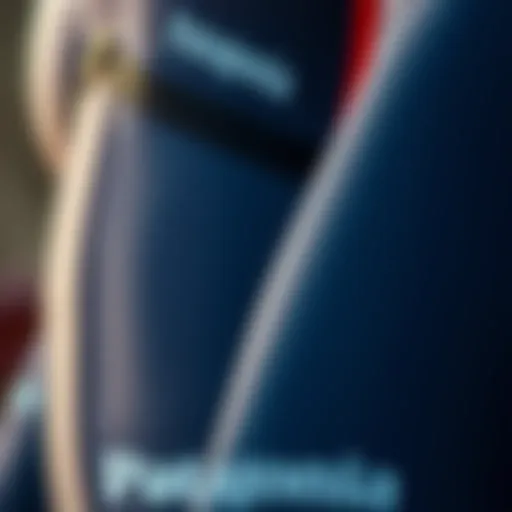Choosing the Best Drone for Surf Fishing Adventures
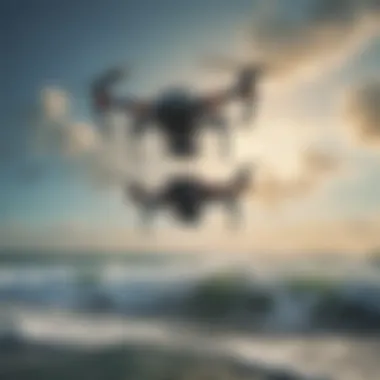

Intro
The allure of surf fishing is undeniable, drawing enthusiasts to beaches across the globe in search of the thrill that comes with reeling in a catch. As the sun peeks over the horizon, the waves lap gently at the shore, and the scent of salt fills the air. But to stay ahead of the game, modern anglers are increasingly turning to technology—in particular, drones. These flying wonders can not only enhance the fishing experience but also provide a unique perspective that seasoned and novice surfers alike appreciate.
In this guide, we’ll unpack the factors that make a drone ideal for surf fishing. It goes beyond just picking a device; it’s about understanding how various functionalities can streamline the fishing process. Battery life, camera quality, and range all come into play as we dissect what characteristics are essential for a successful expedition into the surf zone.
Important to note is how this technology interfaces with the environment. An optimal drone must handle coastal winds, potential saltwater exposure, and the demands of scouting fishing spots from above without losing functionality. This article aims to navigate these considerations, helping you make an informed choice tailored to your fishing needs.
"Drones open up a whole new world for surf anglers, offering views and insights that were once out of reach."
Let’s dive into the critical components of selecting the right drone, setting you on a path to elevate your surf fishing adventures.
Preamble to Drones in Surf Fishing
In an age where technology dives into every nook and cranny of our lives, the realm of surf fishing has not remained untouched. The integration of drones into this outdoor pursuit isn't just a trend; it's a game changer. Understanding the role these devices play can open new doors for both seasoned anglers and those new to the fishing game. By leveraging aerial perspectives, surf fishers can expand their horizons like never before, spotting potential catch areas from above the waves. This article aims to shed light on why selecting the right drone is imperative for enhancing the surf fishing experience.
The Intersection of Technology and Fishing
The confluence of technology and traditional fishing techniques is striking a chord among outdoor enthusiasts. Drones, equipped with advanced cameras and capabilities, allow fishers to gather intel about fishing conditions that would otherwise take hours of scouting. In essence, they bring a bird's-eye view to the process, capable of revealing everything from water temperature variations to schools of fish lurking beneath the surface.
Drones have also become a tool for social connection in the fishing community. By sharing aerial footage from their excursions, anglers can foster camaraderie and exchange tips on local fishing spots. This crossover between technology and fishing highlights how innovation can enhance the joy of being one with nature while simultaneously optimizing the chances of a fruitful catch.
The Rise of Drones in Outdoor Activities
The last decade has seen a significant uptick in drone usage across various outdoor activities, including recreational sports, wildlife photography, and, notably, fishing. As more people aim to experience the outdoors in unique ways, drones have emerged as a powerful ally. It’s not just about capturing stunning vistas anymore; it’s about crafting strategies in angling that are data-driven.
When you look at the evolution of fishing gear, from rods to reels to tackle boxes, drones represent a natural progression. They're not meant to replace traditional methods but rather to complement them. Think of a drone as a modern-day fishing buddy—one that can guide you to where the fish are biting. It’s this fusion of old-school passion and cutting-edge technology that is lifting the fishing experience to new heights.
Fishing’s not just about catching; it’s about understanding and adapting to the environment. The ability to assess conditions quickly with a drone can be the difference between coming home empty-handed or reeling in the big one. As angling practices evolve, so does the necessary equipment, and drones are speeding up that evolution in ways we’re just beginning to uncover.
Key Considerations When Choosing a Drone
When it comes to surf fishing, selecting the right drone can be a game changer. The right drone can simplify the fishing process, provide access to unreachable zones, and enhance overall effectiveness in locating the target catch. With various options flooding the market, it becomes essential to identify key considerations that align with your individual fishing needs. Here we dig into what makes a drone suitable for surf fishing in particular.
In essence, understanding your specific requirements and the capabilities required for this sort of fishing is fundamental. Every angler has unique contexts, from locations to the species they pursue. The right drone can significantly influence fishing success by extending your reach and providing real-time insights on conditions and fish locations.
Understanding the Specific Needs of Surf Fishing
Surf fishing presents distinct challenges, not least when it comes to locating and delivering bait to fish scattered along the coastline. Drones equipped for surf fishing must accommodate these needs with particular specifications. The coastal region often features sandy beaches that can be windy, surf that can be tricky, and potentially sparse fish presence. Here’s where drones shine, enhancing the surf fishing experience with technology.
A drone’s ability to carry bait far from shore allows anglers to cover more water, increasing chances for success. Additionally, the use of real-time scouting allows for understanding of fish movements or conditions thanks to aerial views, making informed decisions easier. For anyone keen to maximize their fishing expeditions, it’s vital to pinpoint drones that combine functionality with reliability.
Drone Specifications That Matter
While the needs vary from angler to angler, certain drone specifications are crucial to focus on. Choosing a drone without considering its technical details might lead to disappointments. Fortunately, breaking it down to key specifications will make the selection process smoother. Here are the top aspects to consider:
Camera Capabilities
The camera is one of the foremost features in a fishing drone. Its ability to deliver high-resolution images or video has a direct effect on locating fish and analyzing the water. Drones equipped with high-definition cameras allow for a detailed view of underwater activities, revealing sea life that may remain invisible from the shore.
One major characteristic to look for is the stabilization technology. A steady shot can easily help assess underwater structures or schools of fish more clearly. This stabilization is important since the surf can generate vibrations when the drone is airborne. The ability to stream footage in real-time adds further advantages, enabling immediate decisions on fishing tactics based on what you see.
Battery Life
Battery life is another critical specification for any fishing drone. Since surf fishing often requires extended time on the water, having enough juice is necessary. A drone that boasts a longer battery life allows you to scout areas without the fear of sudden power loss.
Look for a drone that provides at least 20 to 30 minutes of stable flight time, considering that the return trip needs to be factored in too. Short-lived batteries can lead to mid-flight emergencies, which could be disastrous if you’re operating over open water. Stronger batteries not only allow for prolonged use but also can power attachments or cameras without a hitch.
Flight Range
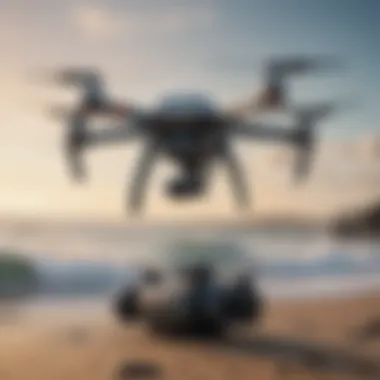

Flight range goes hand in hand with battery life, and it’s paramount for surf fishing. A drone should be capable of covering substantial distances from the operator, which is essential when fishing in large surf zones.
Most fishing drones offer a range of 1,500 meters or more. This capability means that you need not rely on fishing just the near shore; instead, you can cast bait far out where the bigger fish usually lurk. However, ensuring you have good reception and signal strength during operation is equally vital, as weak connection can result in loss of control and potentially sink your investment.
Top Drones for Surf Fishing
When it comes to surf fishing, having the right drone can make all the difference between a day of unproductive casting and landing your target catch. Today, many anglers are turning their heads to the sky, looking for aerial assistance to enhance their fishing experiences. With numerous options on the market, understanding the various types of drones tailored for this activity becomes paramount.
Selecting a drone that suits the demands of surf fishing isn't only about aesthetics or brand popularity; it's about matching technology with practical fishing knowledge. Benefits include: easier location of schools of fish, precise bait delivery, and even monitoring water conditions without the need to wade out into potentially hazardous surf.
Market Leaders in Fishing Drones
The market is flooded with an array of drone brands, but a few stand out as industry titans. Brands such as DJI, Typhoon, and Swellpro have carved their own niche, offering different models that cater specifically to fishing needs.
- DJI has long been recognized for its high-quality camera capabilities, making it easier to scout vast ocean areas with clear visuals.
- Typhoon offers durable drones capable of withstanding harsh weather, perfect for those unpredictable surf days.
- Swellpro takes the cake with waterproof models, allowing them to splash land directly on the water, enhancing retrieval of the device after use.
These are just a few examples of brands that have established a name in the domain of fishing drones, ensuring that anyone looking to invest will have a plethora of options.
Comparison of Leading Models
Specifications
Specifications are the backbone of any drone. They dictate not just performance but also the potential effectiveness for surf fishing. Key characteristics such as camera resolution, battery strength, and flying distance significantly affect your fishing success.
- Camera Resolution: A higher resolution will provide clearer images from above, helping anglers spot fish or obstacles in real-time.
- Battery Strength: Drones like the DJI Phantom boast robust battery life, ensuring your day isn’t cut short. An extended flight time means more opportunities to find that elusive school of fish.
- Flying Distance: Some models, like the Swellpro Splash Drone, can fly significantly farther than others, making them great for anglers looking to cover more ground.
These elements contribute heavily to the overall effectiveness of a drone. The more optimized the specifications, the more robust and reliable an angler’s fishing experience can be.
Features
In addition to specifications, features play a sizable role in the operation and utility of the drones. Popular options come equipped with unique capabilities.
- GPS Tracking: This feature allows the drone to record flight paths, making return trips easier and ensuring that anglers can maximize their chosen fishing spots.
- Follow Me Mode: This allows the drone to autonomously follow an angler, providing continuous aerial views and freeing up the user for other tasks.
- Waterproofing: Models specifically designed for marine environments, like the Swellpro Splash Drone 3, ensure that water damage is not a concern.
There are many available features that can either enhance or limit the fishing experience, depending on the model chosen, hence it's wise to carefully consider which attributes are crucial for your surf fishing discord.
Price Points
Price points vary widely among leading drone models. On one end of the spectrum, you may find high-end drones that offer unique features with the price tag to match. On the other hand, more budget-friendly options provide essential functions without the bells and whistles, reminding anglers of their primary goal: catching fish.
- Premium Models: Expect to pay top-dollar for models equipped with all the advanced features and improved specifications. These often come from well-established brands and guarantee reliability.
- Mid-Range Choices: Finding a balance between quality and cost can lead you to excellent mid-range drones that still offer most necessary features, like decent flight time and GPS functionality.
- Entry-Level Drones: Don't underestimate the value of entry-level models. They are great for beginners who wish to dip their toes into drone fishing without emptying their wallets.
Understanding the price spectrum helps potential buyers make informed decisions while determining what aligns best with their fishing habits and budget constraints.
Evaluating Drone Features for Fishing
When it comes to surf fishing, the right drone can make all the difference between a catch and a bust. Evaluating drone features is about more than just aesthetics or brand name; it’s crucial to understand the specific functionalities that enhance your fishing endeavors. In this ever-evolving field, understanding drone features will help anglers maximize their fishing potential, streamline their operations, and ultimately add enjoyment to their time spent on the water.
Camera Quality and Its Importance
Camera quality might seem like a trivial feature for some, yet it stands at the core of effectively using drones for surf fishing. Why is that? For starters, high-resolution cameras allow anglers to spot schools of fish from a considerable distance. A drone equipped with a high-definition camera can capture crisp images and videos, offering a bird's-eye view of the water below.
Imagine hovering over a designated fishing spot and seeing the depths teeming with potential catches or just a flat, barren expanse. Clear imagery dictates whether to drop your line or move along to a different location.
Key Aspects of Camera Quality:
- Resolution: The higher, the better. 4K cameras are increasingly common and can spot fish lurking in shallow waters.
- Stabilization: Anti-shake features are essential when you're flying in windy conditions; shaky footage can render images nearly useless.
- Zoom Capabilities: Ability to zoom in on distant targets can uncover secret hotspots that might be missed without flying up close.
Mapping and Tracking Capabilities
Another feature worth deeper consideration is mapping and tracking capabilities. The ideal drone should work seamlessly with GPS technology, enabling you to not only locate fish but also map out various fishing spots you visit. This can be an absolute game-changer for both amateur and seasoned anglers.
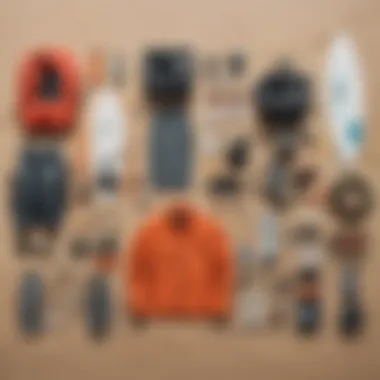

With the proper mapping features, you can lay out a route for your drone to follow, ensuring you cover large bodies of water efficiently. Additionally, good tracking capabilities help to monitor where you've flown, making returning to hot spots easy.
Benefits of Mapping and Tracking:
- Enhances Navigation: Helps prevent getting lost while maximizing the search area.
- Creates Fish Patterns: By mapping your catches against your flying routes, you can analyze where fish are more likely to appear on future trips.
- Interactive Features: Many drones allow you to attach waypoints, making it easier to revisit successful fishing locales.
Payload Capacity for Bait Delivery
A significant aspect that often flies under the radar—no pun intended—is payload capacity. For surf fishing, the ability to carry and deliver bait to hard-to-reach spots can set a successful fishing excursion apart. Drones designed for this purpose must have a sufficient payload capacity to transport bait safely, especially when dealing with heavier loads like live bait.
The convenience of airborne bait delivery cannot be overstated. Instead of casting from the shore and hoping for the best, a drone allows you to drop bait far beyond the surf break where fish might be lurking.
Factors to Consider for Payload Capacity:
- Weight Limitations: Check the manufacturer’s specifications for maximum weight allowances to ensure it fits your bait requirements.
- Release Mechanism: How the drone releases the bait is crucial—look for easy-to-use systems that don't interrupt your fishing experience.
- Durability: Since you might be using heavier and sometimes moist materials, selecting a drone body that's robust enough to handle this kind of work is essential.
As you dive into the world of surf fishing drones, evaluating these features will not only prepare you for success but also ensure that you become savvy in picking out the drone that complements your fishing style. With technology blossoming at a rapid pace, the right features can elevate your experience and yield rewarding days on the water.
Regulatory Considerations in Drone Use
When it comes to using drones for surf fishing, regulatory considerations become paramount. Drones are not just gadgets; they are tools that require a reasonable understanding of local laws, ensuring both the safety of the operator and the preservation of the environment. Not adhering to these regulations can lead to serious consequences, not just for the angler, but also for the fishing community at large. A comprehensive grasp of these guidelines helps in preventing unnecessary legal predicaments while enhancing the overall fishing experience.
Understanding Local Drone Regulations
Navigating the world of drone regulations can feel a tad overwhelming. Each region has its rules, often dictated by local governments or specific natural resource agencies. For instance, some beaches might have restrictions against flying drones entirely or limit the areas in which they can be operated. Knowing your locality’s bylaws can save you a heap of trouble down the line.
Before heading out to catch some waves or seek those elusive fish, it’s essential to check local laws. You might find that regulations concerning drone use vary significantly, sometimes even between adjacent areas. Local powers often impose rules regarding flight altitude, time of operation, and even distance from certain landmarks, such as schools or hospitals.
Additionally, certain drone types, especially those that carry heavier payloads, may also be subject to different regulations compared to lighter models. It pays to do your homework on these matters. Online resources or official local government websites are often a good starting point to acquire this critical information.
Permits and Restrictions in Fishing Areas
Fishing areas are typically governed by specific laws, and the introduction of drones only adds another layer of complexity. Many fishing zones require permits, especially when using drones for underwater assistance or bait delivery. Permits can either be seasonal or year-round, depending on the fishing practices prevalent in that particular area.
Furthermore, certain regions impose restrictions to safeguard the local ecosystem. Drones flying over protected areas can disturb wildlife, which is why many states have instituted strict guidelines. For example, you may need a special permit if you plan to fly over a marine protected area where certain species nest or breed.
Awareness of these limitations not only helps in remaining within legal boundaries, but can also enhance your fishing success.
- Research Necessary Permits: Many areas, especially national parks or wildlife reserves, may require permits for drone operation; check well ahead of time.
- Know No-Fly Zones: Some areas prohibit drone flights entirely to protect wildlife.
- Stay Informed About Seasonal Restrictions: Fish species might have certain spawning seasons where the use of drones is curtailed or entirely forbidden.
Always prioritize local laws to ensure a seamless fishing experience.
By taking the time to understand local regulations and apply for the necessary permits, anglers can avoid unwanted fines while engaging in surf fishing with drones. Integrating drones into your fishing outing can be both exciting and legally prudent if approached with the right knowledge and preparation.
Safety Considerations When Using Drones
In surf fishing, utilizing a drone elevates the fishing experience, but with innovation often comes a set of challenges. Safety considerations when using drones cannot be overstated. Engaging in such a thrilling outdoor activity with technological aids demands an acute awareness of the potential hazards involved. Whether you are a seasoned angler or a greenhorn, understanding the risks and appropriate safety measures is essential. Drones not only improve the efficiency of your fishing endeavors but also introduce elements that can put equipment, individuals, and the environment at risk unless handled properly.
Common Risks Associated with Drone Fishing
Using drones in the context of surf fishing presents specific risks that users should be aware of:
- Collision Risks: Low-flying drones can easily collide with other persons, vehicles, or even wildlife. Unpredictable weather conditions like gusty winds can further exacerbate this risk, sending your drone off its intended path.
- Equipment Damage: Surf and ocean environments can be unforgiving. Saltwater and sand can damage drone internals and optics, rendering them inefficient and shortening their lifespan. Dropping your drone into the harsh water can result in permanent loss.
- Loss of Control: Drones can be susceptible to technical malfunctions, causing loss of control. If your drone flies beyond its operational range or experiences a battery failure, it could spiral down into the sea or become damaged.
- Wildlife Interference: Drones often disturb local wildlife. In areas where bait fish or nesting birds may be present, the noise and sight of a drone might cause unnecessary stress to the ecosystem.
It is crucial to familiarize yourself with these risks and consider them in your pre-flight checks and planning.
Best Practices for Safe Operation
To ensure a safe and rewarding experience while drone fishing, consider these best practices:
- Pre-Flight Checklist: Always conduct a pre-flight checklist to ensure the drone is in optimal working condition. Check battery levels, control signals, and camera functionality before taking off.
- Know the Area: Familiarize yourself with the local surf fishing area. Understanding the geography and potential hazards helps in avoiding unexpected challenges.
- Follow Regulations: Abide by local drone regulations and fishing laws. This involves checking flight restrictions in specific areas, such as near airports or marine wildlife reserves— failing to do so could lead to legal consequences.
- Maintain Visual Line of Sight: Always keep your drone within your line of sight. Losing sight of it can lead to misjudgment and increased risk of crash.
- Respect Wildlife: Be mindful of the ecosystem. Avoid flying the drone near nesting areas or during critical breeding seasons for local fauna.
- Battery Management: Ensure you have sufficient battery left for both the flight to the fishing spot and the return trip. A drained battery miles away from shore could spell disaster.
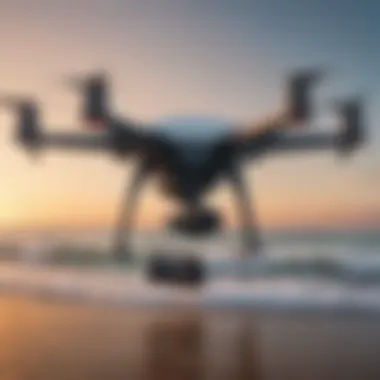

"The key to successful drone fishing lies in merging the thrill of technology with a grounded approach to safety."
By following these recommended practices, you can minimize risks and maximize your enjoyment. Emphasizing safety not only protects your investments but also ensures that your surf fishing experience remains enjoyable and respectful toward nature.
Enhancing the Surf Fishing Experience with Drones
Choosing to integrate drones into surf fishing is no small feat; it's like purchasing a good surfboard—it can make or break your experience. The world of drone fishing is about maximizing the unique advantages these flying machines bring to a deeply traditional pursuit. Drones serve as tech-savvy tools that can elevate the angler's odds by providing insightful data that was previously difficult to collect, or even impossible.
Utilizing Drones for Locating Fish
One of the most significant benefits of using drones in surf fishing is their ability to locate fish more effectively. With a drone equipped with a camera, you can scout vast areas of ocean from above, spotting schools of fish that might be invisible from the shore. Clear visuals can help identify fish species and determine their feeding behavior, aiding your choices for bait types and fishing methods.
For instance, imagine being on a serene beach, the sun beautifly rising over the horizon. You launch your drone and get aerial footage of the water below. Suddenly, you spot a group of Mackerel roaming near a rocky outcrop—data that could turn a lackluster fishing trip into a productive one.
This not only saves time but can also optimize effort; understanding when and where fish are more likely to bite means anglers are less likely to waste time casting lines in unproductive waters.
Real-Time Environmental Monitoring
Drones also permit real-time environmental monitoring. These high-tech tools can gather data related to water conditions such as temperature and clarity. Knowing these variables can make a crucial difference in surf fishing, as they often determine fish behavior and location.
Imagine having a durable drone flown out to check the water temperature a few hundred feet from the beach. If the readings show warmer water, it may lead you to rethink your bait or gear choice, subsequently guiding where you spend your fishing time. The convenience of acquiring immediate insights allows you to adapt and strategize your fishing method on the-go, which is a game changer in effective surf fishing.
"Adapting your strategy based on environmental condition can vastly increase the chances of a successful catch."
Using drones in this way enhances your experience, transforming it into something more focused. The blend of technology with traditional fishing practices opens a world where even those who aren't seasoned pros can approach surf fishing with increased confidence and capability.
When you pair the capabilities of drones with the thrill of surf fishing, not only do you increase your chances of a successful catch, but you can also cultivate a deeper connection to the waters you navigate.
Future Trends in Fishing Drones
The landscape of surf fishing is poised for a significant transformation, thanks to advancements in drone technology. As we explore future trends in fishing drones, several key aspects emerge that will shape how anglers approach their craft. Understanding these trends is pivotal not just for tech enthusiasts but for every fishing aficionado looking to enhance their experience on the water. With innovations on the horizon, we must consider how these developments will impact fishing practices, efficiency, and overall enjoyment.
Technological Innovations on the Horizon
Looking ahead, numerous technological innovations are anticipated to revolutionize fishing drones. These upgrades are not merely bells and whistles but actual enhancements that can make a tangible difference in angling success. For instance:
- Artificial Intelligence Integration: Future drones may utilize AI to identify fish concentrations based on patterns, drastically improving fishing chances. Imagine a drone that can differentiate between species and communicate this data to the angler in real-time!
- Enhanced Battery Life: One of the common complaints about many current models is battery duration. Future innovations are expected to include more efficient batteries that extend flight times, allowing anglers to cover greater distances without the constant need to recharge.
- Advanced Communication Systems: The integration of 5G technology could enable smoother live video feeds from the drone to the pilot's device. This immediate connection allows for better decision-making while on the hunt for fish, making the experience seamless and responsive.
- Improved Payload Capacities: With drones designed for surging surf conditions, increased payload capacities can facilitate larger bait deliveries or even multiple bait drops. This feature could open new avenues for catching larger game.
These technological strides not only promise to enhance user experience, but they also embody the essence of innovation in outdoor sports.
Potential Changes in Fishing Practices
As fishing drones continue to evolve, we can expect shifts in the methodologies employed by surf anglers. Here are a few ways these advancements may influence the sport:
- Data-Driven Decision Making: The rise of data analytics will allow fishermen to optimize their strategies. By analyzing previous catches, weather patterns, and drone-collected data, anglers can refine their approach for more effective fishing trips.
- Emphasis on Sustainability: As awareness grows about the environmental impacts of fishing, drones equipped with eco-friendly technology will gain prominence. Anglers will likely prefer tools that help them minimize their footprint on delicate ecosystems while still achieving their goals.
- Accessibility for Novices: As several companies aim to create user-friendly drone models, surf fishing could become more accessible to beginners. This shift could potentially expand the community of anglers and promote a broader understanding of the sport.
- Increased Collaboration and Community Sharing: With social media platforms thriving, anglers may find new ways to connect with each other about their drone-enhanced fishing experiences. Sharing tips, hotspots, and strategies could become commonplace, leading to a more connected fishing community.
"The future of fishing lies in our ability to adapt to advancing technologies, which can both inform and enrich our angling experiences."
Ending
As we wrap up the discussion on the selection of drones for surf fishing, it’s essential to understand the layers of complexity involved in choosing the right one. The landscape of fishing drones isn’t just filled with flashy gadgets; it’s about finding that perfect balance between functionality and user experience. The right drone can elevate an angler’s experience, facilitating access to hard-to-reach spots and improving catch rates.
Many critical elements come into play when making a choice. As touched on earlier, battery life, range, and payload capacity dramatically influence the effectiveness of the drone in real-world conditions. A drone might boast a crystal-clear camera, but if it's tethered to a short battery life, its practical use during an extensive fishing day becomes questionable. Likewise, understanding local drone regulations cannot be understated; compliance ensures that your fishing adventures remain hassle-free.
Additionally, drones equipped with advanced tracking and mapping capabilities allow for a more strategic fishing approach. Whether it’s locating schools of fish or monitoring the environment for the best conditions, these features contribute to more than just convenience—they support better decision-making.
"Selecting the right drone is like picking the right rod; it can make or break your fishing day."
Recap of Essential Features in Fishing Drones
When summarizing the characteristics that define an optimal surf fishing drone, several features are paramount:
- Camera Capabilities: Look for high-resolution cameras with stable gimbals to capture clear images and videos from above. A good camera aids in scouting out spots from a distance.
- Battery Life: Aim for drones offering substantial flight times, ideally upwards of 30 minutes, to maximize your fishing sessions without frequent recharges.
- Range: A drone with a greater operational distance gives you access to wider fishing areas, increasing your chances of a successful catch.
- Durability: Since surf environments can be rough, a sturdy design that can handle water splashes and the occasional drop is important.
- Payload Capacity: If you're using the drone for bait delivery, ensure it can handle the weight of your payload without compromising flight stability.
Final Thoughts on Selecting the Right Drone
Choosing a fishing drone is not only about the specs on paper but how those specs translate in real-world scenarios. Each angler has different needs based on their habits, the types of fish they're targeting, and the environments they frequent. Therefore, it’s wise to consider personal experiences and preferences while browsing through models.



